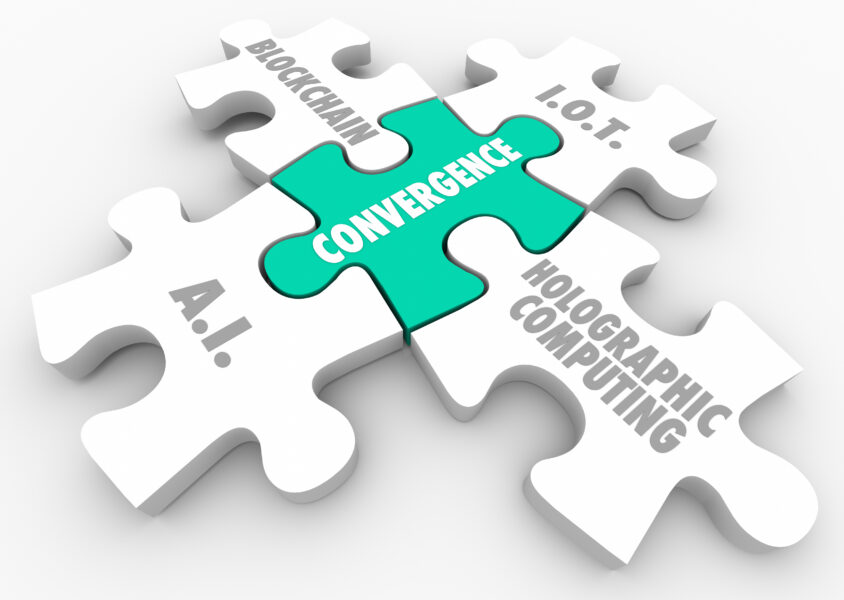
The Convergence of Distributed Ledger Technology and Artificial Intelligence Exemplified by the Lending Process (Part 2)
In the first part of this three-part series on the convergence of artificial intelligence and distributed ledger technology exemplified by the lending process, we explained what convergence means, why the capabilities of DLT and AI complement each other, and what makes the lending process a suitable object of investigation for combining these two technologies.
Remember, technological convergence means that two or more technologies merge into a single system that is more powerful than each of the technologies individually. Since AI and DLT are technologies that have some opposing characteristics (e.g., centrality vs. decentralization; transparency vs. black box), the two technologies complement each other and can compensate for crucial weaknesses of the other. Since the lending process is one of the main processes in the banking business and involves both communication and data analysis (AI) and the transmission of sensitive data (DLT), it is ideally suited for a practical examination of both the prerequisites and the effects of technological convergence.
Analysis of optimization potentials in the lending process
When analyzing the optimization potential of DLT and AI for the lending process, we differentiate between three types of AI applications. The first and simplest application is Robotic Process Automation (RPA). RPA applications are mostly used for repetitive, monotonous and therefore error-prone tasks in banking, e.g. for transaction processing and data transfer. Processes automated by means of RPA are characterized by operational agility, scalability, 24/7 availability, geographical independence and freedom from errors (Vishnu et al., 2017). The second type of AI application is Cognitive Engagement (CE), which builds on RPA but requires a higher level of intelligence as CE applications are more flexible in performing tasks and analyze actions or generate insights. This type of application includes language-processing chat bots and recommendation systems with learning components that are categorized into supervised or unsupervised learning. The third and most complex AI type is Predictive Analytics (PA). The distinguishing feature compared to CE is the prediction component, which enables PA applications to anticipate future scenarios based on large structured or unstructured data by analyzing relationships and/or patterns of past events. Banking-related PA applications include tools for e.g. cross-selling or fraud detection (Eckerson, 2007).
In the next step we examined how much the individual process steps can be improved by using DLT or one of the three AI application types. With the help of a so-called Impact Assessment Framework, the optimization potential of an application of the technologies could be classified into the levels high, medium and low (Figure 2).

The results show that in the overall end-to-end lending process, nine sub-processes show potential for the application of DLT, while four sub-processes can benefit from the application of Robotic Process Automation, five sub-processes from Cognitive Engagement and four sub-processes from the application of Predictive Analytics. Comparing the effects of DLT and AI, there is an obvious complementary interaction between DLT and AI technologies in the lending process. From our point of view, this is because DLT and AI are two technologies that come into play at different stages of information processing. While RPA and CE receive and transform sensor-based information, DLT is an infrastructure that stores, transmits and verifies information. In other words, AI transforms the perception of the real world into machine-readable data, which is digitally stored on the DLT and in turn processed by AI into new knowledge.
In the following, we will examine and describe in more detail the combination of DLT with the three AI application types in the higher-level end-to-end lending process in a total of three scenarios:
- Scenario (I) deals with the joint application potential of DLT and RPA, which we identified in four process steps: authentication, data entry, completeness check and archiving. Within order acceptance, both the customer identification and authentication processes can be automated on the basis of “if-then” actions. The combination shows enormous value creation potential in terms of cost and time savings if the RPA application supports the DLT for converting data types or representing data.
- During the evaluation of the benefits of an integration of DLT and CE in the second scenario (II), we identified three application areas. In general, CE can be implemented in all processes that require virtual support of human-to-human and human-to-machine communication. This is because CE can convert physical input into a digital format and prepare it for further processing. Convergence provides transparency as the type and content of the AI input is stored on the DLT, reduces variable costs and time, and also increases reliability for the customer.
- In scenario (III), the combination of DLT and predictive analytics, the DLT can increase the credibility and uniformity of the data due to its decentralized and unchangeable capabilities in the initialization phase. In combination with PA, incoming customer inquiries can be structured in such a way that the PA application can anticipate unexpressed customer needs by matching the inquiry with previous customer journeys, thus opening up cross-selling potential. The optimized process leads to faster, more reliable and – due to better estimation of default rates – lower-risk processing of the credit application, at the end of which the credit can be released automatically.
The potential of technological convergence of AI and DLT for the credit approval process is high: Convergence can increase the degree of automation as well as the transparency and security of the credit approval process on both sides of the contractual relationship. Tomorrow, in the third and final part of this series, we will look at which process characteristics promote which type of convergence of AI and DLT.
Sources:
Vishnu, S., Agochiya, V. and Palkar, R. (2017). “Data-centered Dependencies and Opportunities for Robotics Process Automation in Banking.” Journal of Financial Transformation / Capco Institute 45, 68–76.
Eckerson, W. W. (2007). “Predictive analytics. Extending the Value of Your Data Warehousing In-vestment.” TDWI Best Practices Report (1), 1–36.
